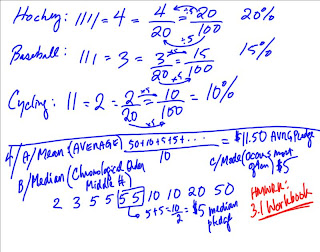data management do you remember intro corrections below:
homework 3.1 workbook
gr7

Tuesday, 16 October 2012
oct 16 geography
1.2 Regions pg.22-
Region: an area with similar characteristics based on landforms, climate, precipitation, soil, vegetation, population, culture (language, customs, religion), political boundaries (municipal, provincial, federal), neighborhoods and communities.
Wilderness Region: no human population (forest, barren cold land i.e. tundra)
Physical region: mountains, rock/geologic formations, vegetation, desert examples include the following:
Climate/soil/vegetation region: what grows there is affected by soil, climate and precipitation
Rural Region: open countryside, farming & agriculture
Urban Region: location of major cities - mix of residential/commercial/industrial
Human Region: Toronto's cultural districts and neighborhoods composed of similar language, customs, religions, ethnicities.
Time-Zone Region: Toronto is located in EDT Eastern Daylight Time Zone
Fuctional Region: the % of residential, commercial, industrial areas & transportation systems
Multi-Factor Region: combination of physical & human factors
Ontario's Niagara Escarpment
Region: an area with similar characteristics based on landforms, climate, precipitation, soil, vegetation, population, culture (language, customs, religion), political boundaries (municipal, provincial, federal), neighborhoods and communities.
Wilderness Region: no human population (forest, barren cold land i.e. tundra)
Physical region: mountains, rock/geologic formations, vegetation, desert examples include the following:
Climate/soil/vegetation region: what grows there is affected by soil, climate and precipitation
Rural Region: open countryside, farming & agriculture
Urban Region: location of major cities - mix of residential/commercial/industrial
Human Region: Toronto's cultural districts and neighborhoods composed of similar language, customs, religions, ethnicities.
Time-Zone Region: Toronto is located in EDT Eastern Daylight Time Zone
Fuctional Region: the % of residential, commercial, industrial areas & transportation systems
Multi-Factor Region: combination of physical & human factors
Ontario's Niagara Escarpment
- extends from Tobermory (Bruce) to Niagara Falls (Queenston)
- protected biosphere, different animal habitats, plants, ecosystems, conservation area, cliffs, recreation, mineral resources
- wetlands, meadows, waterfalls, rock formations, forests
oct 16 science lab 2 individually or with 1 partner
1.2 More About Matter pg.14-16
Purpose: To determine what happens when matter changes state from a solid-liquid-gas.
Hypothesis: If I place a small piece of ice in a plastic sandwich bag, squeeze out most of the air, place it in a microwave oven for 60-90 seconds approximately then I think...(this will happen)
Observations:
1. Through the door of the microwave, I noticed...
2. After seeing the bag inflate, I removed it from the microwave and noticed...
Analysis: According to the particle theory, particles in matter move faster and spread farther apart when they are heated. When matter is cooled, its particles move back closer together. Knowing this, I learned the ice particles in this experiment...(did what?) My hypothesis was...(correct, somewhat correct, or incorrect because)
due friday oct 19th
Purpose: To determine what happens when matter changes state from a solid-liquid-gas.
Hypothesis: If I place a small piece of ice in a plastic sandwich bag, squeeze out most of the air, place it in a microwave oven for 60-90 seconds approximately then I think...(this will happen)
Observations:
1. Through the door of the microwave, I noticed...
2. After seeing the bag inflate, I removed it from the microwave and noticed...
Analysis: According to the particle theory, particles in matter move faster and spread farther apart when they are heated. When matter is cooled, its particles move back closer together. Knowing this, I learned the ice particles in this experiment...(did what?) My hypothesis was...(correct, somewhat correct, or incorrect because)
due friday oct 19th
Subscribe to:
Comments (Atom)











